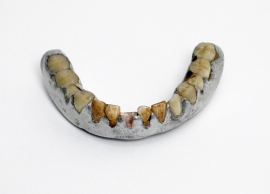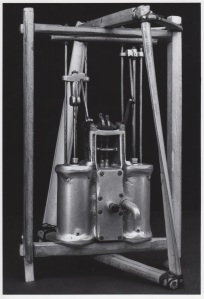
The only grievance of Robertson’s was that he couldn’t drink his hot tea with them in! The story of these “wild teeth” spread and led to the telling of a tall tale of Robertson killing a bear, making the teeth, and eating the bear with its own teeth!
Turns out, they belonged to Erwin A. “Nimrod” Robertson, an early Alaskan pioneer from Maine who settled along the Yukon near Eagle in 1898. His reason to venture to the Klondike Gold Rush was to raise $1,000.00 to build his aluminum flying machine and start a flying business. He used his homemade teeth, forged from an aluminum pot lid set with a mix of carved sheep, caribou, and bear teeth, for about 25 years.
Over the forty years he spent in the Eagle area, he had many occupations including placer mining, dentist, jeweler, as well as serving on the Eagle Common Council, Chief of Police, marshal, magistrate, and attorney. Because of his inventive genius, he was an all around tinkerer, making inventions and fixing things for people. “Nimrod”, an endearing nickname given to him, was quite the resourceful genius and the teeth were just one of his many inventions.
He made hunting blades from large wood files that were tempered by a secret processes. It was said that these knives would trim the corrugation off a silver dollar as easily as an orange peel with a paring knife. He was well known for his gold puzzle rings and would give it away to anyone who could take it apart and put it together again within a specified time.

Catalog Number UA79-004-0001
“To lift, or rise, and propel itself through the air by up and down strokes of its wings as a bird. Power for moving wings to be supplied by specially designated gas engine or by specially adapted commercial gasoline engine” (Robertson’s own description of his invention)
In our collections we also have an aluminum motor that he fabricated to go along with an early airplane he engineered called “Nimrod’s Bird Machine” that he had patented in 1892 or 1894.
Another of his creations is a famous and impressively accurate 60”x 80” relief map of the Eagle area, which he constructed from newspaper, magazines, hematite and moose blood. The map was sent to Seattle in 1909 for the Alaska-Yukon Exposition and again in 1962 for the World’s Fair. Today it’s on display at the Eagle Historical Society & Museums.
At 81 years old, in 1940, he decided to make a prospecting trip to his placer mines at Seventy-mile, Alaska. The weather that November quickly turned on him. Realizing he was short of provisions and would unlikely make it home, he pulled up his parka hood and lay to rest, under dripping water. Later, his body took a week to chip out of the ice and he was buried at the Eagle Cemetery.
P. Aloysius Regnad
Oliver Wendell Holmes Senior (1809 - 1894)
He's remembered for all of the above, but few people seem to realize he was connected to them all.
He studied medicine in France, and helped to introduce the stethoscope to the United States. He coined the word "anesthesia", and was an early proponent of the germ theory of disease, especially with regard to puerperal fever (also called childbed fever), an illness that affected women who had recently given birth, and was very often fatal. Holmes believed that doctors and midwives were a major vector of this disease, and that the practice of washing one's hands, and instruments, could greatly reduce its occurrence. He went to great lengths to promote his belief, and was eventually proved correct.
As a poet, he wrote "Old Ironsides", which was published in 1830 and was influential in the eventual preservation of the USS Constitution. He continued to write poems, and prose works throughout his life, as well as medical articles.
In 1860, he invented the American Stereoscope, a device for viewing three dimensional images. Holmes believed there was nothing new in his invention, aside from its simplicity, and did not patent it.
Mar 29, 2021
Captain
William T. Shorey (July 13, 1859 – April 15, 1919) was a late 19th-century American whaling ship captain known to his crew as the Black Ahab.
The Only African American Ship Captain on the West Coast of the United States in the Late-1880s and 1890s
May 13, 2023
Captain
Jean Baptiste Charbonneau (February 11, 1805 – May 16, 1866) was a Native American-French Canadian explorer, guide, fur trapper, trader, military scout during the Mexican–American War, alcalde (mayor) of Mission San Luis Rey de Francia and a gold digger and hotel operator in Northern California. His mother was Sacagawea, a Shoshone Native who worked as a guide and interpreter for the Lewis and Clark Expedition. Charbonneau spoke French and English and learned German and Spanish during his six years in Europe from 1823 to 1829. He spoke Shoshone and other western Native American languages, which he picked up during his years of trapping and guiding.[citation needed]
Jean Baptiste's father was also a member of the Lewis and Clark expedition, a French Canadian explorer and trader named Toussaint Charbonneau. Jean Baptiste was born at Fort Mandan in North Dakota. In his early childhood, he accompanied his parents as they traveled across the country. The expedition co-leader William Clark nicknamed the boy Pompey ("Pomp" or "Little Pomp"). After the death of his mother, he lived with Clark in St. Louis, Missouri, where he attended St. Louis Academy. Clark paid for his education. Sacagawea and Toussaint Charbonneau also had a second child, a daughter named Lizette Charbonneau; however, because she receives only occasional mention in Clark's papers, her life remains unclear beyond her third birthday.[1]
Jean Baptiste and Sacagawea appear on the United States Sacagawea dollar coin. He is the second child depicted on United States currency. Pompeys Pillar on the Yellowstone River in Montana and the community of Charbonneau, Oregon are named for him.
Jean Baptiste Charbonneau - Wikipedia
May 16, 2023